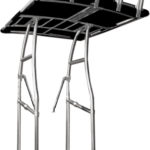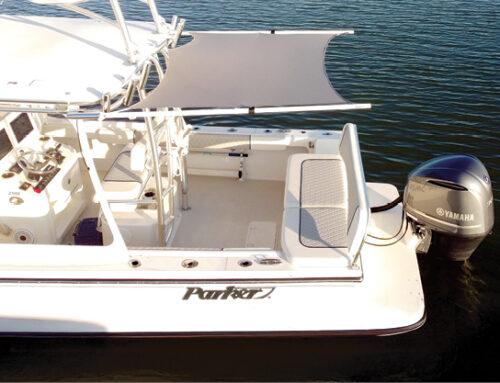Exceptional boat exteriors
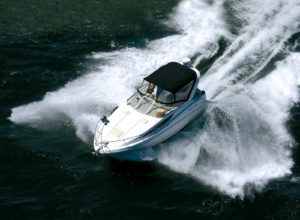
Marine fabricators are creating original exterior applications as their customers seek protection from the elements – and want to look good doing it. Employing the latest in technology, today’s durable yet attractive fabrics and hardware meet the needs of boaters requesting a high-quality product that makes them stand apart from the crowd.
The economic downturn left nearly every market in a state of unrest, and the boating industry is no exception. In the past several years, fewer boats have been built, but the news isn’t all bad, as fabricators and OEMs are turning a sluggish marketplace into opportunity.
“The volume of units is not what it was, but we are seeing that people are willing to spend more money today to get higher-quality, higher-end products,” says Mike Kushner, vice president of sales at TACO Metals in Miami, Fla. “Everyone is asking for new products and innovation and trying to differentiate themselves from their competitors.”
To that end, marine fabricators are employing the newest in durable, aesthetically pleasing fabrics and hardware in exterior applications to meet the requests of their discerning clientele. Material manufacturers and fabricators share their insights on the latest developments in components, as well as the new applications they’re crafting for use on the outside of boats.
Form meets function in fabrics
In terms of exterior marine fabrics, “we are seeing that consumers are more interested today in comfort, style, texture and performance than ever before,” says Bill McDaniel, marine market manager for Glen Raven LLC in Glen Raven, N.C., makers of Sunbrella. “Softer applications on exterior seating and performance of the fabrics used there are becoming more important to the consumer.”
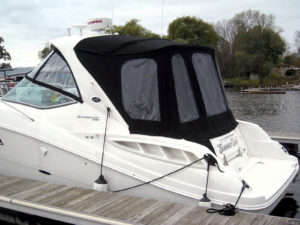
The owner of a 35 – foot Sundancer 330 from Sea Ray came to Marine Tops unlimited with a request to create a squared-off back end with no framework.
Exterior seating options, for instance, reflect homeowners’ desire for backyard “rooms” with quality furnishings. “Performance fabrics in today’s colors and patterns are making their way from the home and the outdoor lifestyle ultimately onto the boat,” McDaniel notes. Not only do the fabrics look good, but they stand up to the harsh sun and cleaning dictated by the marine environment.
MarChem CFI, a manufacturer of coated and solution-dyed polyester fabrics for exterior marine applications, reports that marine fabricators are on the lookout for a fabric that can do it all. “Everyone wants the perfect product that will solve all their problems,” says Jonathan Chakales, the company’s Southeast regional sales representative. “That demand from fabricators grows as the generations turn.”
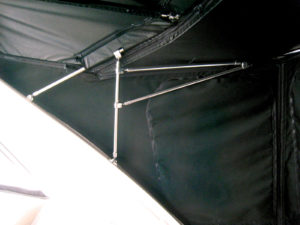
The result: Steve Griffith, owner of Marine Tops, crafted a cantilever camper back where the system hinges off a forward point on the boat and creates the top section.
To meet—and ideally surpass—fabricator expectations, MarChem is rolling out Top Notch Elite. “It’s a lightweight, breathable, solution-dyed fabric with the same color retention, water repellency and strength as our original Top Notch product,” Chakales notes.
Keith Purves, owner of Riverside Covers in Fort Myers, Fla., has seen an influx of upscale marine fabrics, including high-performance exterior-grade vinyls and canvas options. Additionally, his customers are showing more interest in the warranties available for fabrics and threads.
“In the economic quagmire that we are in, when people finally decide they are ready to spend money on their boat, they want to make sure they are getting the most bang for their buck,” Purves says. “Contrary to popular belief that cheaper is better, my customers at least recognize that if they are going to spend their money, they want to do it wisely. And one way they can do that and feel justified in the expense right now is to make sure something is going to be long lasting and provide quality, not just now, but for years to come.”
Such is the case with Purves’s use of PTFE threads, which he says are easier than ever to work with and perform better than the traditional polyester alternative. “When I describe to a customer that PTFE thread is 100-percent guaranteed in writing for life, it is quite a selling point,” Purves says.
Fabric manufacturers continue to look for ways to improve their products. For example, three years ago, Glen Raven unveiled its next-generation Sunbrella, which featured increased water repellency. “We continue to explore and develop products for all surfaces of the boat, such as alternative seating products, flooring and sun-control products,” McDaniel says. Glen Raven plans to roll out new options to fabricators and at regional and national consumer boat shows in the coming months.
Hardware gets sleeker
“Hardware wise, manufacturers keep coming out with better designs that are sleeker, lower profile and more user-friendly,” Purves says.
For its part, Accon Marine LLC in Clearwater, Fla., aims to meet the goals of fabricators and their customers with its line of Quick Release Bimini Top hardware for standard top-mount installs, as well as rail-mount and flush-mount versions.
“All products in this line allow the top to be easily installed and removed without the need for pins and screws,” explains president and owner Bernd Czipri. “The post stays attached to the bimini top and simply snaps into the base when needed. To remove the top, you simply slide the button back.”
The manufacturer also makes several different shims, from 10-degree shims to radiused shims. “This allows for some wiggle room if the bimini poles and the base don’t line up exactly,” Czipri adds, “and the radiused ones are for if the base must be mounted on tubing or railing.”
In addition to telescoping outriggers for saltwater fishing boats, TACO Metals manufactures a series of aluminum, stainless steel and plastic products for pipe tubing and hardware for marine canvas and metal fabrication. These days, however, more fabricators are choosing stainless steel hardware in place of aluminum or plastic for its quality and durability.
“We make patented stainless steel ball and socket fittings, which have become very popular throughout the industry,” Kushner explains. “The design has a Delrin plastic insert that allows for fuller rotation and a rattle-free fit between the top slide and mount. It takes out a lot of the noise. Also, it gives more rotation on the top so that the fittings don’t lock up.”
Creating unique exteriors
Fabricators are taking advantage of high-quality fabrics and hardware to improve upon traditional exterior applications such as bimini tops, enclosures and dodgers. What’s more, these shops are getting creative with new offerings that lead the way in form and function.
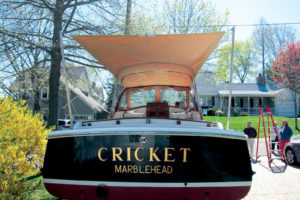
Hood Marine Canvas has started installing a product called an awning strut, manufactured by Performance Textiles. The product offers sun protection at the aft end of the boat without the big framework. Special sockets are anchored into the boat’s deck. Poles are placed into the sockets and a piece of canvas is tensioned by the poles.
At Riverside Covers, Purves is fabricating laceless T-tops for fishing and center console boats. Traditionally, a piece of canvas is laced onto the framework with a piece of rope, while a laceless top is mechanically fastened by sandwiching the fabric between the framework and a readily available rub rail extrusion. Erasing the lacing line, however, gives the boat an ultra-clean, high-end appearance that “makes it look very similar to a fiberglass hardtop,” Purves says, adding that when it comes to fabric selection, “the lack of unraveling on a cut seam is very important.” Stainless steel fasteners complete the look.
In addition, Purves is taking a new approach to flooring. In lieu of marine carpeting, he is using DECKadence, a high-performance carpet alternative made of 100-percent PVC. “It’s excellent in many situations where carpet can’t stand up to the rigors of the marine environment,” he notes.
TACO Metals has developed leaning posts and T-tops completely upholstered, finished and ready to install out of the box for replacements and retrofits on existing center console boats. The kit “is ideal for a small shop that cannot quickly redo a boat,” Kushner says. “Fabricators like that they can keep one unit in their showroom or shop to show a customer. It allows them to really expand their product line and offer a quick turnaround because we ship the product within a couple of days, and they can get it right on the boat.”
-
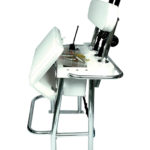
- Taco Metals Neptune Premium Leaning Post (left) features posts made from anodized aluminum and fiberglass. A fiberglass storage unit under the vinyl seat offers a secure, dry place for tackle and fishing gear. The Neptune T-top (right) is upholstered, finished and ready to install out of the box. It’s designed as a replacement or retrofit for center console boats. The anodized aluminum T-top is pre-welded and engineered to provide strength and durability.
Kushner notes the growing sophistication of wakeboard boats, for which TACO provides the fittings and the extrusions for applications such as stereo speakers, lighting and storage racks mounted on the tops.
From a distributor standpoint, Drew Nelson, marine market manager for Tri Vantage, headquartered in Cleveland, Ohio, has noticed an increase of aft deck shades. “It is not like in the old days where you built a permanent structure on the back of your boat. The aft deck shade might be paneled or tensioned onto the back, but when you don’t want it, you can take it down.” He adds that the shades can be made of a variety of fabrics. “It used to be that years ago, there weren’t many mesh fabrics on a boat, but for temporary shading applications, you are starting to see more of them.”
Similarly, Hood Marine Canvas in Merrimac, Mass., has started installing a product called an awning strut, manufactured by Performance Textiles. “Some people like to have sun protection at the aft end of the boat, but they don’t want the big framework that they have to store somewhere,” says Mark Hood, owner of Hood Marine Canvas. “With the awning strut, special sockets are anchored into the boat’s deck. Poles are placed into sockets and feature a pulley system and a cleat. The system is very rigid and can angle out. A piece of canvas is tensioned by these poles and pulls out to offer shade without a large framework involved.”
Count Steve Griffith as another fabricator who’s fielding requests from boat owners to minimize framework. A customer bought a 35-foot Sea Ray and told Griffith, owner of Marine Tops Unlimited in Madison, Wis., that while he didn’t want any framework off the deck of the boat, he did want all the extra space of having a big squared-off back end. Griffith created a cantilever camper back so that the system hinges off a forward point on the boat and creates the top section.
“Everything attaches to that, leaving the entire back end of the boat wide open,” Griffith explains. “There are no poles or other obstructions.”
Hardware manufacturers are taking note of these new applications, too. “Based on customer feedback and suggestions, we have modified our system to include applications for quick-release fender hangers and quick-release drink holders,” says Accon’s Czipri. “Our quick-release system has also been used to secure fishing rods to the boat for high-speed trolling, and for securing coolers and dock boxes.”
By taking advantage of high-quality fabrics and hardware, marine fabricators are creating unique covers, tops, enclosures and other exterior applications that offer superior performance and aesthetics. And these offerings can lead to new customers. Just ask Griffith: After he installed the camper back on the 35-foot Sea Ray, the boat owner’s friend—himself the owner of a new 33-foot Sea Ray—liked what he saw so much that he contacted Griffith to produce the same thing.
Holly O’Dell is a freelance writer from Pine City, Minn.
 TEXTILES.ORG
TEXTILES.ORG 


